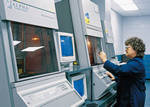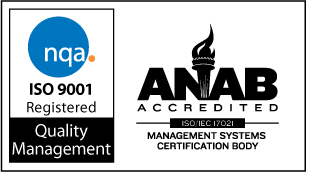
|
7108
S. Alton Way, Unit I |
(303) 758-2728
Home > O-ring, Seal Design > Vacuums > Outgassing
Outgassing and Weight Loss of Elastomers
 Outgassing
in elastomers is the release of volatile materials when the elastomers
are heated. Outgassing affects vacuum performance. Outgassed components
may include water vapor from the reaction of acid scavengers (i.e.,
MgO) and acid during the curing process of elastomers. Also, low-molecular-weight
species of antioxidants and UV stabilizers, unreacted polymer residues
and degraded products may appear as outgassed components. Many traditional
seal materials contain small amounts of low-molecular-weight plasticizers,
or process aids, that can volatilize under vacuum conditions. Water
vapor and carbon dioxide are also absorbed into seal elastomers exposed
to air.
Outgassing
in elastomers is the release of volatile materials when the elastomers
are heated. Outgassing affects vacuum performance. Outgassed components
may include water vapor from the reaction of acid scavengers (i.e.,
MgO) and acid during the curing process of elastomers. Also, low-molecular-weight
species of antioxidants and UV stabilizers, unreacted polymer residues
and degraded products may appear as outgassed components. Many traditional
seal materials contain small amounts of low-molecular-weight plasticizers,
or process aids, that can volatilize under vacuum conditions. Water
vapor and carbon dioxide are also absorbed into seal elastomers exposed
to air.
Weight loss measurements are often used as an indicator of outgassing in elastomers. Specific values for vacuum weight loss are dependent on the elastomer and sample conditioning.
Heating an o-ring seal for several hours at 100°C has been shown to reduce outgassing significantly. This "bake-out" procedure is less important for seals made from modern fluorocarbon and perfluorocarbon elastomers as the manufacturing process includes a several-hour post-curing step at temperatures above 200°C. Vacuum baking can provide even less outgassing.
Outgassing Rates of Elastomers and Various Materials
| Material | RATE* (10-9 mbar/sec-cm2) |
RATE** (10-8 Torr-liter/sec) |
| Stainless Steel | 13.5 | |
| Steel, Chrome Plated | 7.1 | |
| Stainless
Steel, Electropolished |
4.3 | |
| Aluminum | 6.3 | |
| Nitrile | 3,500 | 300 |
| KEL-F | 40 | 4 |
| Silicone | 18,000 | 2,000 |
| Fluoroelastomer | 1,140 | 2,000 |
| Fluoroelastomer, baked | 4 | 0.2 |
| Perfluoroelastomer | 0.3 | |
| PTFE | 300 | 400 |
| Polyimide | 900 | 80 |
| Pyrex glass | 7.4 |
* Leybold
Inficon, Inc.-"Vacuum" 1997
** Peacock, R.N., J. Vac. Sci. Technol., Jan./Feb. 1980
Next Topic Trapped Gas in O-Rings and Seals
We are located in the Denver Technological
Center in a suburb of Denver, Colorado
©1997-2017, Problem Solving Products, Inc.
Website Map | Privacy Statement
| Terms of Use

